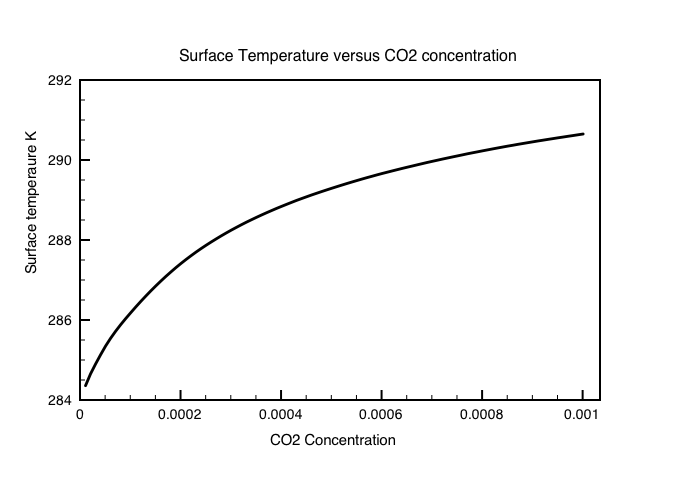- There is relatively little controversy about the function of CO2 as a greenhouse gas
- Without greenhouse gases, the world would be too cold to support life
- The greenhouse effect is not enough by itself to support claims of ‘dangerous’ global warming
Greenhouse gases are gases whose properties are said to be ‘heat-trapping’ — they absorb infrared energy and re-emit it, scattering it and thereby keeping it in the atmosphere rather than allowing its passage out to space. This heat-trapping phenomenon can be demonstrated in a laboratory, and is the most basic scientific premise of the climate change debate. However, what happens in a laboratory cannot always be applied to our understanding of what happens in the real world, where other factors combine to make things more complicated.
It is important to understand that the greenhouse effect is natural and required for life on Earth, but which is a process that has, according to advocates of far-reaching green policies, been adversely altered by industrial emissions. Without natural greenhouse gasses, the world would be about 33°C colder than it is today. Most of the heat from the Sun would be lost to space. The most dominant greenhouse gas in the atmosphere producing this warming effect is water vapour, which accounts for at least half of the total contribution of all greenhouse gases to the greenhouse effect, with additional significant warming coming from clouds. Nitrous oxide, methane and ozone are other key global warming gases, but excess carbon dioxide (CO2) is the major greenhouse gas of concern. The problem is therefore a matter of degree: how much has the atmosphere been altered by anthropogenic greenhouse gases.
Climate sensitivity
The scientific term for this question about degree is ‘equilibrium climate sensitivity’: how much warmer will the planet be after a doubling of CO2 in the atmosphere. But this question is complicated by the problem of climate feedbacks — secondary effects of global warming, which in turn either produce further warming or cooling. This article is about greenhouse gases, and CO2 in particular. So a discussion about climate sensitivity here is out of place, except to point out that the global warming potential of CO2 — without feedbacks — is not a major controversy of the climate debate. (Global warming from feedbacks, and in particular radical scenarios driving model-based projections of future warming are what create more differences of opinion about the role of CO2 in the atmosphere.)
There is substantial (but not total) agreement across lines of debate about the influence of CO2. The projected warming from CO2 itself, absent any feedbacks, is about 1°C. This is relatively uncontroversial (compared to other claims within the climate debate), because, as discussed above, the effect of CO2 can be estimated with comparative ease, without extensive use of computer simulation. Moreover, this amount of warming (for a doubling of CO2) alone would not be capable of producing ‘catastrophic’ effects of the kind that environmentalists and some climate scientists claim will be the outcome of continued CO2 emissions.
Greenhouse gas saturation
In 2018, the late Stephen Hawking repeated a common misconception about the function of greenhouse gases in the atmosphere. Citing the case of Venus in a warning to encourage political action on climate change, he claimed that ‘This is what happens when greenhouse gases are out of control’. Venus has an atmosphere which is 96.5% CO2, and the temperature is 467°C. Some people also mistakenly believe that Venus’s extreme temperature is owed to its closer (than Earth’s) proximity to the Sun. But in fact, the major reason for Venus’s temperature is the density of it’s atmosphere, which is equivalent to approximately 92 times the air pressure at sea level on Earth, or being 0.9 km under water. There is close to zero chance of Earth’s climate suffering the same fate as Venus’s.
The misconception is that adding more CO2 increases the warming of the atmosphere indefinitely. But whereas the first doubling of CO2 is estimated to cause 1°C of warming (without feedbacks), the second doubling would produce less additional warming This is because, after the first doubling, the atmosphere is already opaque to most wavelengths of infrared radiation — the more additional CO2 there is, the less warming effect it has. In other words, the effect of greenhouse gas is logarithmic. The following chart produced by physicist Clive Best demonstrates the relationship between temperature (in degrees Kelvin) against CO2 concentration.

Current CO2 concentration is about 415.02 ppm (or 0.000415 on the above chart) and have risen from about 280 ppm (0.00028) since the 1850s. Best notes that the modern era’s concentration of about 300 pm has caused a (natural) 4°C increase in temperature, compared to an atmosphere free of CO2, and “a doubling of CO2 from 300 – 600 ppm results in a further ~1.5C increase in surface temperatures”. It is important to remember first that this does not take account of feedbacks, and that therefore this does not negate global warming as a problem. However, it does help to answer claims about the possibility of runaway warming.
Some climate policy advocates have attempted to answer this observation of CO2’s logarithmic effect. But these attempts are often highly-charged political polemics and provide non-scientific analogies, rather than explanations. The problem is that seemingly sceptical attempts to give perspective to scientific claims are often perceived as attempt to completely rule them out. Whereas, as discussed above, global warming is a question of degree, some political campaigners prefer to portray the issues in debate as true-or-false, leading only to a hostile atmosphere precluding discussion across lines of disagreement.
